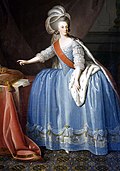House of Braganza
The House of Braganza (Portuguese: Casa de Bragança; Portuguese pronunciation: [bɾɐˈɣɐ̃sɐ]), officially the Most Serene House of Braganza (Portuguese: Sereníssima Casa de Bragança), is an important imperial, royal, and noble house (dynasty) of Portuguese origin. It is a branch of the House of Aviz. The House changed from being powerful dukes of Portuguese nobility, to ruling as the monarchs of Portugal and the Algarves, from 1640 to 1910. They were also monarchs of Brazil, from 1815 to 1889. The heir to the Portuguese throne was usually given the title of "Duke of Braganza".
| Most Serene House of Braganza Sereníssima Casa de Bragança | |
|---|---|
 | |
| Parent house | Portuguese House of Burgundy by way of the House of Aviz |
| Country | |
| Founded | 1442
Empire of Brazil: 1889 |
| Founder | Afonso, Duke of Braganza |
| Current head | Duarte Pio, Duke of Braganza |
| Final ruler | United Kingdom of Portugal, Brazil and the Algarves: João VI (1822)
Kingdom of Portugal: Manuel II (1910)
Empire of Brazil: Pedro II (1889) |
| Titles |
|
| Estate(s) | of Portugal and Brazil |
History
The House of Braganza was founded in 1442. This is when Afonso, 8th Count of Barcelos, was made Duke of Braganza.[1] Alfonso (Alfonso I) was an illegitimate son of King João I of Portugal, of the House of Aviz.[1] He was made a duke by his nephew, King Afonso V of Portugal. The feudal dukes quickly collected a fortune in properties, titles, and power. By the mid 1600s, the House was the most powerful in all of Portugal. It was also of the greatest houses of Iberia.[2]
The House of Braganza became the reigning house of Brazil, first, when the United Kingdom of Portugal, Brazil, and the Algarves was created in 1815.[3] The United Kingdom lasted until 1822, when the Brazilian Empire became independent from Portugal. The new Brazilian nation was led by Prince Pedro of Braganza, heir to the Portuguese throne, who ruled as Emperor Pedro I of Brazil, as well as King Pedro IV of Portugal. Until 1835, the Portuguese Braganzas were still in the line of succession to the Brazilian throne. The House was deposed (removed) from the Brazilian throne, in 1889, when Brazil was proclaimed a republic.[4]
The House continued to be the claimant house to the Brazilian throne until 1921. This is when Isabel, Princess Imperial of Brazil, daughter of Emperor Pedro II of Brazil, died. Her claim passed to her son, Prince Pedro Henrique of Orléans and Braganza. Thus the House of Orléans-Braganza became the claimant house to the former monarchy of Brazil. Pedro Henrique died in 1981. The current claimant is his eldest son, Prince Luiz.[5]
In Portugal, King Carlos I of Portugal was assassinated in 1908. Also killed in the attack was his eldest son. His younger son, Manuel II, became king.[6] When the Portuguese Republic was established, in 1910, King Manuel II and the rest of the Braganzas went into exile.[7]
Famous members
- Maria I of Portugal the first female monarch of Portugal known for her suspected madness and making Brazil a colony.
- Mariana Victoria of Spain. Married a King of Portugal and the mother of Queen Maria I.
- Pedro II of Brazil. An Emperor of Brazil.
House Of Braganza Media
Afonso I, first Duke of Braganza and founder of the House of Braganza
Isabel of Braganza was the first to intermarry with the royal family, as wife of Infante João, Constable of Portugal.
The Palace of the Dukes, in Guimarães, was seat of the House of Braganza from 1420 until Fernando II of Braganza was executed for treason by King João II in 1483.
Jaime I restored the Braganzas' status after his father's execution and built the Ducal Palace of Vila Viçosa.
In 1640, John IV of Portugal became the first Braganza to reign as King of Portugal, starting the Portuguese Restoration War.
Queen Catherine of Braganza, wife of Charles II of England, credited with introducing the English to tea-drinking, popular with the Portuguese nobility.
Queen Maria I became the first monarch of Brazil with the creation of the United Kingdom of Portugal, Brazil and the Algarves in 1815.
King-Emperor João VI's children split the Braganzas into 3 branches: the Brazilian Imperial branch, the Portuguese Constitutional branch, and the exiled Miguelist branch.
References
- ↑ 1.0 1.1 Queen Isabel I of Castile: Power, Patronage, Persona, ed. Barbara F. Weissberger (Woodbridge, Suffolk; Rochester, NY: Tamesis, 2008), p. 21
- ↑ Edward McMurdo, The History of Portugal (London: S. Low, Marston, Searle, & Rivington, 1888-89), p. 363
- ↑ Robert Walsh, Notices of Brazil in 1828 and 1829, Volume 2 (London: F. Westley and A.H. Davis, 1830), p. 532
- ↑ John B. Means, 'Latin American Report: Brazil: The Hemisphere's Lost Empire', The North American Review, Vol. 257, No. 2 (Summer, 1972), pp. 9–10
- ↑ Roberto De Mattei, The Crusader of the 20th Century: Plinio Corrêa de Oliveira (Leominster: Gracewing, 1998), p. 99
- ↑ Douglas L. Wheeler, Republican Portugal: A Political History, 1910-1926 (Madison: University of Wisconsin Press, 1978), p. 44
- ↑ Paul H. Lewis, Latin Fascist Elites: The Mussolini, Franco, and Salazar Regimes (Westport, CT: Praeger, 2003), p. 130









